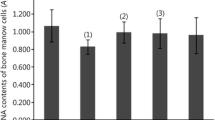Abstract
The radioprotective properties of indralin when it is used in combination with cystamine and mexamine are studied in inbred mice and rats. The mice and rats are irradiated with γ rays emitted by 60Co at doses of 9.0 and 9.5 Gy, respectively. A combined parenteral administration of indralin and cystamine in mice at doses of 25 mg/kg each is revealed to potentiate the radioprotective properties of indralin up to a level close to the ED50 effect, while the separate application of these drugs in doses of 25 mg/kg each has no or a very weak radioprotective effect. Indralin (50 mg/kg) and mexamine (12 mg/kg) injected intraperitoneally in rats are found to almost completely eliminate the animal mortality caused by gastrointestinal acute radiation syndrome; the mortality in the control radiation group reaches 60% on the seventh day after the animals have been exposed to radiation at a dose of 9.5 Gy. However, if bone-marrow acute radiation syndrome develops under the above condition of super-lethal dose, the radioprotectors have a low radioprotective effect. Under the this condition, the combined application of indralin and mexamine in the same doses has 50% of radioprotective effect reached by applying these radioprotectors separately in double doses.
Similar content being viewed by others
References
P. P. Saksonov, V. S. Shashkov, and P. V. Sergeev, Radiation Pharmacology (Meditsina, Moscow, 1976) [in Russian].
F. Devik, Br. J. Radiol. 27(320), 463–466 (1954).
I. G. Krasnykh, P. G. Zherebchenko, V. S. Murashova, et al., Radiobiologiya 2(2), 298–303 (1962).
J. R. Maisin, Nature 204(4954), 196–197 (1964).
M. V. Vasin, P. P. Saksonov, and V. S. Shashkov, Farmakol. Toksikol. (Moscow) 33(4), 501–507 (1970).
L. F. Semenov and E. A. Prokudina, Med. Radiol. 2(3), 35–40 (1957).
A. N. Grebenyuk, V. V. Zatsepin, N. V. Aksenova, et al., Radiats. Biol. Radioekol. 50(4), 475–480 (2010).
M. V. Vasin, I. B. Ushakov, L. A. Semenova, and V. Yu. Kovtun, Radiats. Biol. Radioekol. 41(3), 307–309 (2001).
Author information
Authors and Affiliations
Corresponding author
Additional information
Original Russian Text © M.V. Vasin, V.V. Antipov, S.N. Komarova, L.A. Semenova, A.A. Galkin, 2011, published in Radiatsionnaya Biologiya. Radioekologiya, 2011, Vol. 51, No. 2, pp. 243–246.
Rights and permissions
About this article
Cite this article
Vasin, M.V., Antipov, V.V., Komarova, S.N. et al. Radioprotective properties of indralin combined with cystamine and mexamine. BIOPHYSICS 56, 914–916 (2011). https://doi.org/10.1134/S000635091105023X
Received:
Published:
Issue Date:
DOI: https://doi.org/10.1134/S000635091105023X



